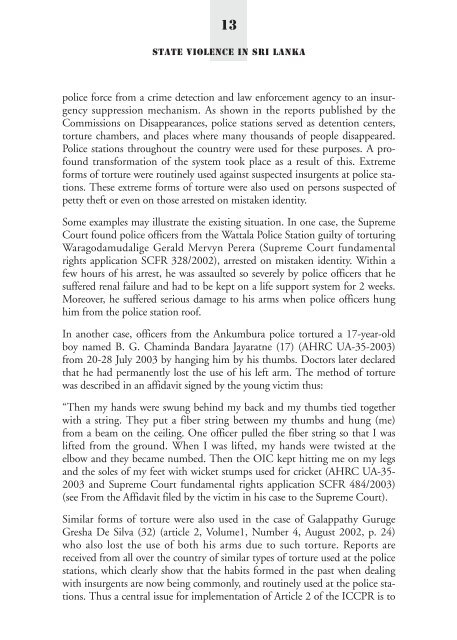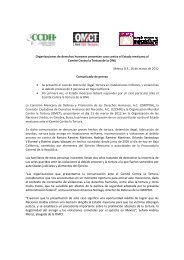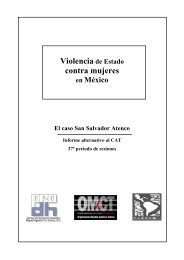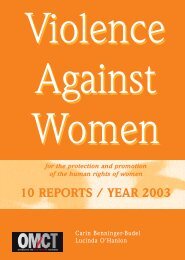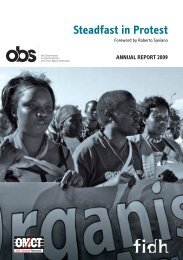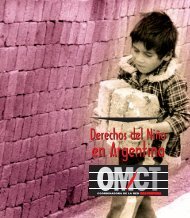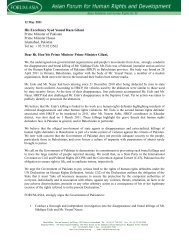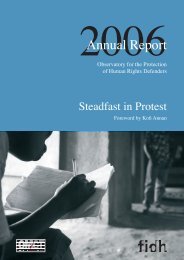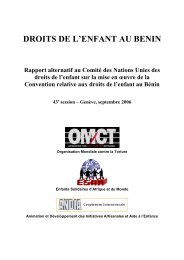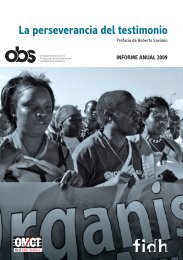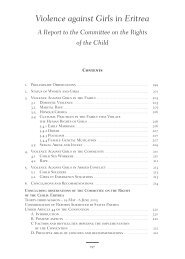State Violence in Sri Lanka - World Organisation Against Torture
State Violence in Sri Lanka - World Organisation Against Torture
State Violence in Sri Lanka - World Organisation Against Torture
You also want an ePaper? Increase the reach of your titles
YUMPU automatically turns print PDFs into web optimized ePapers that Google loves.
13<br />
<strong>State</strong> <strong>Violence</strong> <strong>in</strong> SRI LANKA<br />
police force from a crime detection and law enforcement agency to an <strong>in</strong>surgency<br />
suppression mechanism. As shown <strong>in</strong> the reports published by the<br />
Commissions on Disappearances, police stations served as detention centers,<br />
torture chambers, and places where many thousands of people disappeared.<br />
Police stations throughout the country were used for these purposes. A profound<br />
transformation of the system took place as a result of this. Extreme<br />
forms of torture were rout<strong>in</strong>ely used aga<strong>in</strong>st suspected <strong>in</strong>surgents at police stations.<br />
These extreme forms of torture were also used on persons suspected of<br />
petty theft or even on those arrested on mistaken identity.<br />
Some examples may illustrate the exist<strong>in</strong>g situation. In one case, the Supreme<br />
Court found police officers from the Wattala Police Station guilty of tortur<strong>in</strong>g<br />
Waragodamudalige Gerald Mervyn Perera (Supreme Court fundamental<br />
rights application SCFR 328/2002), arrested on mistaken identity. With<strong>in</strong> a<br />
few hours of his arrest, he was assaulted so severely by police officers that he<br />
suffered renal failure and had to be kept on a life support system for 2 weeks.<br />
Moreover, he suffered serious damage to his arms when police officers hung<br />
him from the police station roof.<br />
In another case, officers from the Ankumbura police tortured a 17-year-old<br />
boy named B. G. Cham<strong>in</strong>da Bandara Jayaratne (17) (AHRC UA-35-2003)<br />
from 20-28 July 2003 by hang<strong>in</strong>g him by his thumbs. Doctors later declared<br />
that he had permanently lost the use of his left arm. The method of torture<br />
was described <strong>in</strong> an affidavit signed by the young victim thus:<br />
“Then my hands were swung beh<strong>in</strong>d my back and my thumbs tied together<br />
with a str<strong>in</strong>g. They put a fiber str<strong>in</strong>g between my thumbs and hung (me)<br />
from a beam on the ceil<strong>in</strong>g. One officer pulled the fiber str<strong>in</strong>g so that I was<br />
lifted from the ground. When I was lifted, my hands were twisted at the<br />
elbow and they became numbed. Then the OIC kept hitt<strong>in</strong>g me on my legs<br />
and the soles of my feet with wicket stumps used for cricket (AHRC UA-35-<br />
2003 and Supreme Court fundamental rights application SCFR 484/2003)<br />
(see From the Affidavit filed by the victim <strong>in</strong> his case to the Supreme Court).<br />
Similar forms of torture were also used <strong>in</strong> the case of Galappathy Guruge<br />
Gresha De Silva (32) (article 2, Volume1, Number 4, August 2002, p. 24)<br />
who also lost the use of both his arms due to such torture. Reports are<br />
received from all over the country of similar types of torture used at the police<br />
stations, which clearly show that the habits formed <strong>in</strong> the past when deal<strong>in</strong>g<br />
with <strong>in</strong>surgents are now be<strong>in</strong>g commonly, and rout<strong>in</strong>ely used at the police stations.<br />
Thus a central issue for implementation of Article 2 of the ICCPR is to


